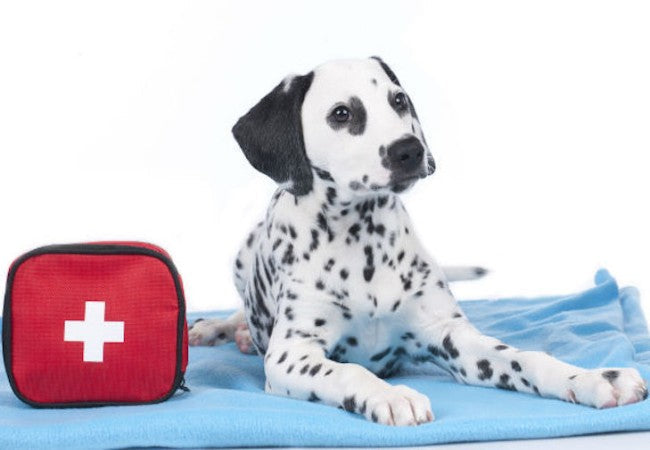Vet Guide to 2025 Pet First‑Aid Kits: Must‑Have Items & Emergency Care 🩺🐶

In this article
Vet Guide to 2025 Pet First‑Aid Kits: Must‑Have Items & Emergency Care 🩺🐶
By Dr. Duncan Houston BVSc
Accidents and medical emergencies can strike anytime—whether at home, on a hike, or road trip. As a veterinarian, I can’t stress enough how vital it is for pet owners to be prepared with a well‑stocked first‑aid kit. This guide covers everything from basic tools and medications to emergency protocols, plus real‑time veterinary support from Ask A Vet. 🏥🐶🐱
1. Why a Pet First‑Aid Kit Is Essential 🛡️ (≈250 words)
Emergencies—cuts, choking, allergic reactions, heatstroke—can escalate quickly. A first‑aid kit gives you the means to respond before veterinary help arrives. Having tools and supplies on hand allows you to:
- ⚠️ Stabilize injuries and control bleeding.
- 📉 Monitor symptoms like fever or shock.
- 📞 Give accurate info to your vet during consultations.
With Ask A Vet, you can access immediate chat or video advice to guide you through emergencies—even before heading to the clinic.
2. Core Items to Include (≈400 words)
Your kit should be portable, well-organized, and refreshed regularly (every 6 months). Here are ten essential items based on veterinary recommendations :
- Emergency Contact Card & Records: List of your vet, nearest 24‑hour hospital, poison hotlines, plus copies of medical records.
-
Bandage & Wound Supplies:
- Self‑adhering wraps, gauze pads/rolls, vet wrap, adhesive tape.
- Blunt‑tipped scissors and tweezers.
- Disposable gloves.
- Wound Care Products: Antimicrobial wipes, sprays, or ointments. Check with your vet before use.
- Pet Thermometer: Digital rectal thermometer, plus optional under‑arm types.
- Eye Flush & Lubrication: Sterile saline rinse and soothing gels for eye irritations.
- Nail Clipper & Styptic Powder: To trim broken nails and stop bleeding.
- Needle‑less Syringe: For oral fluids or wound cleaning.
- Probiotics: Helpful for digestive upset; use vet-recommended brands.
- Transport Aids: Slip leash, muzzle, towel—great for transport or controlling an injured pet.
- Cleanup Supplies: Towels, pet-safe wipes; emergencies can get messy.
3. Medications & Special Items (≈300 words)
Only include OTC medications that your vet approves. Recommended options include:
- Diphenhydramine (Benadryl): For mild allergic reactions—ask your vet for the correct dosage.
- Blood‑clotting Powder: Useful for minor cuts or torn nails.
- Hydrogen Peroxide (3%): For inducing vomiting in toxin ingestion—but only with vet approval.
- Oral Rehydration Solutions: For dehydration, especially in heat-related illnesses or GI upset.
4. Emergency Tools & Extras (≈350 words)
Beyond basics, include:
- Muzzle (basket type): Prevent bites when an injured pet is scared—especially for breathing-sensitive breeds.
- Tick Remover & Tweezers: For removing embedded ticks or splinters.
- Splint Materials: Rolled gauze or padded board for immobilizing fractures.
- Flashlight & Penlight: Essential for inspecting wounds or eyes in low light.
Bonus: include emergency PPE like face masks and eye protection—especially useful if handling unknown body fluids.
5. Pet‑Specific Kits for Cats & Small Mammals (≈300 words)
The above list is suitable for dogs, but adjust for other pets:
- Cats: Smaller bandages, syringe for tiny doses. Avoid hydrogen peroxide!
- Small mammals/reptiles: Nail clippers, heat sources, gentle restraint towels, and species-specific medications.
- Breed considerations: Flat-faced breeds may need adjustable basket muzzles; giant breeds require larger bandages and thermal packs.
6. Maintaining & Customizing Your Kit (≈200 words)
Best practices:
- ✔️ Check kit every 3–6 months: replace expired meds and worn items.
- ✔️ Keep it in a waterproof, brightly-colored container.
- ✔️ Break into modules: home kit, car kit, travel-ready pouch.
- ✔️ Tailor contents to activities—hiking kits need extra cold packs and longer record copies.
7. What to Do in an Emergency (≈300 words)
The ABCs: Assess—Stabilize—Call a Vet
- Assess: Check consciousness, bleeding, breathing, injuries.
- Stabilize: Apply pressure to bleeding, cool for heatstroke, clean wounds gently, use muzzle if needed.
- Call a Vet: Contact Ask A Vet now for real‑time chat/video support, or head to ER if breathing troubles, uncontrolled bleeding, seizures.
For example, if your pet swallows something toxic, hydrate, keep calm, and get immediate Ask A Vet guidance before heading to a clinic.
8. Emergency Checklist & Quick Tips (≈150 words)
- 📋 Medical card & records
- 🧷 Bandages, gauze, vet wrap, scissors, tweezers, gloves
- 🩹 Antimicrobial care, styptic powder
- 🌡️ Thermometer, eye wash, clean towels
- 💊 Vet-approved meds: Benadryl, rehydration salts
- 🚨 Tools: muzzle, tick remover, cold/heat packs, flashlight
- 🎒 Extras: treats, collapsible bowl, pouch for travel
- ✔️ Label everything clearly, rotate supplies often
9. Brands You Can Trust:Ask A Vet 🌟
- Ask A Vet: Access licensed vets anytime via chat/video. Perfect to guide you through using kit items or determining when to head to a clinic.
10. Empowerment Through Education (≈200 words)
Having a kit is only half the battle—know how to use it. Consider:
- Taking a pet first‑aid class (local shelter, Red Cross, vet clinics).
- Practicing simple skills—thermometer use, wound bandaging, muzzle fitting.
- Using a laminated emergency procedure chart in your kit.
And remember—during any emergency, it’s okay (and wise) to say “I don’t know”—contact Ask A Vet right away for professional guidance. 🩺
Conclusion: Be Prepared, Stay Calm & Save Lives (≈150 words)
Preparedness is pet parent empowerment. A well-stocked kit, combined with trusted supplies from and support from Ask A Vet, means you can confidently manage emergencies—big or small. Remember:
- Stay calm and act quickly.
- Use your kit wisely.
- Know when to escalate to professional care.
Your preparedness can make all the difference—protecting the lives you love most. 🐾❤️






